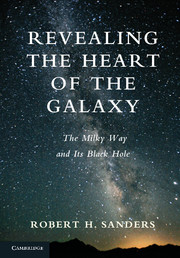Book contents
- Frontmatter
- Contents
- Acknowledgements
- 1 Introduction: The Luminous Pathway
- 2 The Discovery of the Milky Way Galaxy
- 3 The New Physics
- 4 Parting the Veil with Radio Astronomy
- 5 The Violent Universe
- 6 New Windows on the Galactic Center
- 7 The Milky Way as a Barred Spiral Galaxy
- 8 The Evolving View of Active Galactic Nuclei
- 9 The “Paradox of Youth”: Young Stars in the Galactic Center
- 10 Stellar Orbits in the Galactic Center, QED
- 11 Black Holes Here, Black Holes There…
- 12 Traces of Activity: Past, Present, and Future
- 13 After Words: Progress in Astronomy
- References
- Index
4 - Parting the Veil with Radio Astronomy
Published online by Cambridge University Press: 05 December 2013
- Frontmatter
- Contents
- Acknowledgements
- 1 Introduction: The Luminous Pathway
- 2 The Discovery of the Milky Way Galaxy
- 3 The New Physics
- 4 Parting the Veil with Radio Astronomy
- 5 The Violent Universe
- 6 New Windows on the Galactic Center
- 7 The Milky Way as a Barred Spiral Galaxy
- 8 The Evolving View of Active Galactic Nuclei
- 9 The “Paradox of Youth”: Young Stars in the Galactic Center
- 10 Stellar Orbits in the Galactic Center, QED
- 11 Black Holes Here, Black Holes There…
- 12 Traces of Activity: Past, Present, and Future
- 13 After Words: Progress in Astronomy
- References
- Index
Summary
Kapteyn's Famous Student
Within five years of Kapteyn's death in 1922, his view of the Universe had been overturned. By 1930 it was generally accepted that the Milky Way Galaxy was one of many such systems supported against its own gravity by rotation, as had been supposed by Kant. This altered perception of the Galaxy was largely due to the work of the Swedish astronomer Bertil Lindblad and to Kapteyn's own student, Jan Oort (born 1900).
Oort (Figure 4.1) received his doctoral degree in Groningen in 1921 (the doctoral is roughly equivalent to a master's degree). After spending several years at Yale Observatory he was invited back to Leiden by de Sitter, and there he spent the remainder of his long active career.
For his PhD dissertation, defended in Groningen in 1926, Oort had studied the motions of halo stars, objects belonging to the Galaxy but distributed, as the globular clusters, in a large spheroidal halo surrounding the disk of the Milky Way. He was perplexed by the high velocities of these stars and the extremely skewed velocity distribution: they all seemed to be moving in the same direction. Then, in 1927, Lindblad demonstrated that Kapteyn's two star streams could be understood in terms of differential rotation of the Milky Way disk; which is to say, the system rotates not like a solid body, as a phonograph record, but the stars at any radial distance from the center revolved about the center at a rate determined by the Galactic gravitational force at that point.
- Type
- Chapter
- Information
- Revealing the Heart of the GalaxyThe Milky Way and its Black Hole, pp. 38 - 50Publisher: Cambridge University PressPrint publication year: 2013



